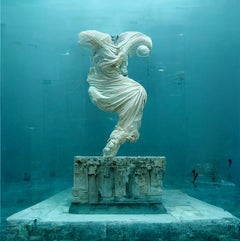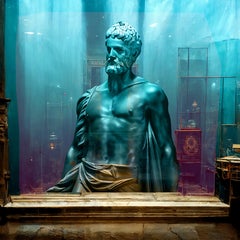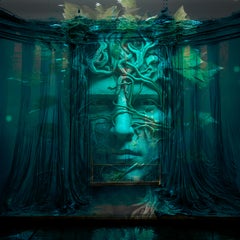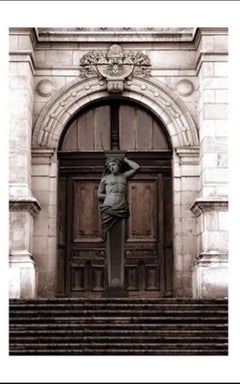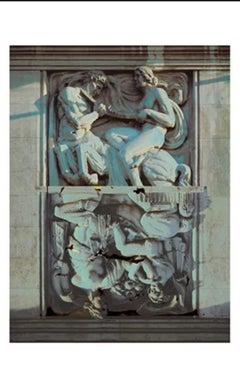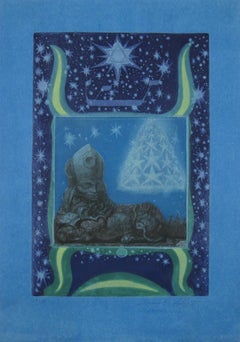Paula Craioveanu Prints and Multiples
Romanian, b. 1976
Trained in Bucharest and New York as architect and painter. Holds a degree in Architecture and a PhD in Visual Arts. Presently working as a full-time artist.(Biography provided by Paula Craioveanu Studio)
to
1
9
7
9
4
3
9
5
2
Overall Height
to
Overall Width
to
16
6
3
3
3
2
2
2
1
1
1
1
1
1
1
1
1
16
148
995
735
669
636
10
10
6
6
6
Artist: Paula Craioveanu
UNDER the SEA 5 by Paula Craioveanu NewMedia print/canvas large 27.5x27.5in
By Paula Craioveanu
Located in Forest Hills, NY
Under the Sea 5 by Paula Craioveanu, New Media composition printed on canvas
Size is 27.5 x27.5in / 70x70cm
part of my "NeoMythology" series.
Shipped rolled in a tube.
Category
2010s Surrealist Paula Craioveanu Prints and Multiples
Materials
Canvas, Archival Pigment
UNDER the SEA 3 by Paula Craioveanu NewMedia print/canvas large 27.5x27.5in
By Paula Craioveanu
Located in Forest Hills, NY
Under the Sea 3 by Paula Craioveanu, New Media composition printed on canvas
Size is 27.5 x27.5in / 70x70cm
part of my "NeoMythology" series.
Shipped rolled in a tube.
Category
2010s Surrealist Paula Craioveanu Prints and Multiples
Materials
Canvas, Archival Pigment
UNDER the SEA 4 by Paula Craioveanu NewMedia print/canvas large 27.5x27.5in
By Paula Craioveanu
Located in Forest Hills, NY
Under the Sea 5 by Paula Craioveanu, New Media composition printed on canvas
Size is 27.5 x27.5in / 70x70cm
part of my "NeoMythology" series.
Shipped rolled in a tube.
Category
2010s Surrealist Paula Craioveanu Prints and Multiples
Materials
Canvas, Archival Pigment
UNDER the SEA 4 by Paula Craioveanu NewMedia print/canvas large 27.5x27.5in
By Paula Craioveanu
Located in Forest Hills, NY
Under the Sea 4 by Paula Craioveanu, New Media composition printed on canvas
Size is 27.5 x27.5in / 70x70cm
part of my "NeoMythology" series.
Shipped rolled in a tube.
Category
2010s Surrealist Paula Craioveanu Prints and Multiples
Materials
Canvas, Archival Pigment
Guardian signed #2/20 Paula Craioveanu Photograph 20x16in in mat 28x20in
By Paula Craioveanu
Located in Forest Hills, NY
UNDER THE SKIN 5
Surreal Nude, part of my "Under the Skin" series.
Printed on Hahnemuhle art photo paper with white borders, size is 20x16in. In mat overall size 28x20in.
This par...
Category
2010s Surrealist Paula Craioveanu Prints and Multiples
Materials
Photographic Paper
Centaurs signed #2/20 Paula Craioveanu Photograph 20x16in in mat 28x20in
By Paula Craioveanu
Located in Forest Hills, NY
UNDER THE SKIN 5
Surreal Nude, part of my "Under the Skin" series.
Printed on Hahnemuhle art photo paper with white borders, size is 20x16in. In mat overall size 28x20in.
This par...
Category
2010s Surrealist Paula Craioveanu Prints and Multiples
Materials
Photographic Paper
Guardians signed #2/20 Paula Craioveanu Photograph 20x16in in mat 28x20in
By Paula Craioveanu
Located in Forest Hills, NY
UNDER THE SKIN 5
Surreal Nude, part of my "Under the Skin" series.
Printed on Hahnemuhle art photo paper with white borders, size is 20x16in. In mat overall size 28x20in.
This par...
Category
2010s Surrealist Paula Craioveanu Prints and Multiples
Materials
Photographic Paper
UNDER the SEA 2 by Paula Craioveanu NewMedia print/canvas large 27.5x39in
By Paula Craioveanu
Located in Forest Hills, NY
Under the Sea 2 by Paula Craioveanu, New Media composition printed on canvas
Size is 27.5 x39in / 70x100cm
part of my "NeoMythology" series.
Shipped rolled in a tube.
Category
2010s Surrealist Paula Craioveanu Prints and Multiples
Materials
Canvas, Archival Pigment
UNDERWATER DREAM 3 by Paula Craioveanu Photocollage 19.5x26.5in
By Paula Craioveanu
Located in Forest Hills, NY
Underwater Dream 3 by Paula Craioveanu, Digital Photocollage 19.5 x26.5in / 50x70cm
part of my "NeoMythology" series.
Printed on Hahnemuhle art photo paper with white borders
Shi...
Category
2010s Surrealist Paula Craioveanu Prints and Multiples
Materials
Photographic Paper
UNDER the SEA 1 by Paula Craioveanu NewMedia print/canvas large 27.5x39in
By Paula Craioveanu
Located in Forest Hills, NY
Under the Sea 1 by Paula Craioveanu, New Media composition printed on canvas
Size is 27.5 x39in / 70x100cm
part of my "NeoMythology" series.
Shipped rolled in a tube.
Category
2010s Surrealist Paula Craioveanu Prints and Multiples
Materials
Canvas, Archival Pigment
UNDER THE SKIN 3 signed #20/20 by Paula Craioveanu Surreal Nude Photography
By Paula Craioveanu
Located in Forest Hills, NY
Under the Skin #3
Surreal Nude, part of my "Under the Skin" series.
Printed on Hahnemuhle art photo paper with white borders, size is 12.5x12.5in.
This particular one is signed and...
Category
2010s Surrealist Paula Craioveanu Prints and Multiples
Materials
Photographic Paper
Under the Skin 5 signed #2/20 Paula Craioveanu Photograph 20x16in in mat 28x20in
By Paula Craioveanu
Located in Forest Hills, NY
UNDER THE SKIN 5
Surreal Nude, part of my "Under the Skin" series.
Printed on Hahnemuhle art photo paper with white borders, size is 20x16in. In mat overall size 28x20in.
This par...
Category
2010s Surrealist Paula Craioveanu Prints and Multiples
Materials
Photographic Paper
PICTOPOETRY 1 signed #1/20 by Paula Craioveanu Photograph 20x16in in mat 28x20in
By Paula Craioveanu
Located in Forest Hills, NY
Surreal Nude, part of my "Pictopoetry" series.
Printed on Hahnemuhle art photo paper with white borders, size 20x16in. In mat overall size 28x20in.
This particular one is signed and...
Category
2010s Surrealist Paula Craioveanu Prints and Multiples
Materials
Photographic Paper
PICTOPOETRY 3 signed #20/20 by Paula Craioveanu Photograph 20x16in in mat 28x20
By Paula Craioveanu
Located in Forest Hills, NY
PICTOPOETRY 3 signed #20/20 by Paula Craioveanu Photograph 20x16in in mat 28x20
Surreal Nude, part of my "Pictopoetry" series.
Printed on Hahnemuhle art photo paper with white bord...
Category
2010s Surrealist Paula Craioveanu Prints and Multiples
Materials
Photographic Paper
PICTOPOETRY 4 signed #20/20 by Paula Craioveanu Photograph 20x16in in mat 28x20i
By Paula Craioveanu
Located in Forest Hills, NY
Surreal Nude, part of my "Pictopoetry" series.
Printed on Hahnemuhle art photo paper with white borders, overall size 20x16in.
This particular one is signed and numbered 20 of 20 (e...
Category
2010s Surrealist Paula Craioveanu Prints and Multiples
Materials
Photographic Paper
PICTOPOETRY 2 signed #2/20 by Paula Craioveanu Photograph 20x16in in mat 28x20in
By Paula Craioveanu
Located in Forest Hills, NY
Surreal Nude, part of my "Pictopoetry" series.
Printed on Hahnemuhle art photo paper with white borders
This particular one is signed and numbered 2 of 20 (edition of 20).
Has been...
Category
2010s Surrealist Paula Craioveanu Prints and Multiples
Materials
Photographic Paper
Related Items
Ernst Fuchs Sphinx Mystagoga Surreal Color Etching Vienna Fantastic Realism 1967
By Ernst Fuchs
Located in Meinisberg, CH
Ernst Fuchs
(Austrian, 1930 - 2015)
The Sphinx Mystagogo
Sheet Nr. 6 from the Folio “Die Sieben Bilder und Sprüche der Sphinx”, published in Autumn of 1967 by Galerie Sydow in Frankfurt, Germany.
• Aquatint Etching
• Ed. 79/99
• Sheet ca. 59 x 41.5 cm
• Plate signed
• Signed & numbered by the artist in pencil
Worldwide shipping for this object is complimentary - There are no additional charges for handling & delivery.
Ernst Fuchs was an Austrian painter, draftsman, printmaker, sculptor, architect, stage designer, composer, poet, and one of the founders of the Vienna School of Fantastic Realism.
I discovered him through H.R. Giger ‘s work, who himself was greatly inspired by the creations of Fuchs and on several occasions exhibited his friend ‘s art in his museum, the Château St-Germain, Gruyères, Switzerland.
I actually own the original folio box...
Category
1960s Surrealist Paula Craioveanu Prints and Multiples
Materials
Paper, Ink, Aquatint, Etching
Free Shipping
H 23.23 in W 16.34 in
Nude with Veils ( Nu aux Voilettes) Salvador Dali Original Engraving 1975
By Salvador Dalí
Located in Paonia, CO
Nude with Veils ( Nu aux Voilettes ) portrays a female nude with long hanging breasts, a crutch instead of a head and a veil streaming off the top of the crutch with the left ar...
Category
1970s Surrealist Paula Craioveanu Prints and Multiples
Materials
Engraving
CUBIST ROOM (PICASSO)
By Ferjo, Fernando de Jesus Oliveira
Located in Aventura, FL
Lithograph in colors on paper. Hand signed and numbered by the artist. AP edition. Sheet size 23.5 x 11.25 inches. Image size approx 19.5 x 9.75 inches.
Artwork is in excellen...
Category
21st Century and Contemporary Surrealist Paula Craioveanu Prints and Multiples
Materials
Lithograph, Paper
German Surrealist Hans Bellmer Etching Engraving Print Cecile Reims Surrealism
By Hans Bellmer
Located in Surfside, FL
After Hans Bellmer (German, 1902-1975)
Surrealist engraving, etching
after drawings from a 1942 notebook,
engraved in 1974-75 by Cecile Reims
Printed by L'Atelier de Chalcographie du Louvre, Paris,
Having printed monogram lower left in plate, pencil notations and #7/10 and 'Musee du Louvre' blindstamp verso
Dimensions: Sheet 11 X 7.5, Plate size 6.5 X 4
Hans Bellmer ( 1902 – 1975) was a Polish born German artist, best known for his drawings, etchings that illustrates the 1940 edition of Histoire de l’œil, and the life-sized female sculpture mannequin dolls he produced in the mid-1930s. Historians of art and photography also consider him a Surrealist photographer.
Bellmer was born in the city of Kattowitz, then part of the German Empire (now Katowice, Poland). Up until 1926, he worked as a draftsman for his own advertising company.
Bellmer is most famous for the creation of a series of dolls as well as photographs of them. He was influenced in his choice of art form in part by reading the published letters of Oskar Kokoschka (Der Fetisch, 1925) and Surrealism. Bellmer's puppet doll project is also said to have been catalysed by a series of events in his personal life.
Hans Bellmer takes credit for provoking a physical crisis in his father and brings his own artistic creativity into association with childhood insubordination and resentment toward a severe and humorless paternal authority. Perhaps this is one reason for the nearly universal, unquestioning acceptance in the literature of Bellmer's promotion of his art as a struggle against his father, the police, and ultimately, fascism and the state. Events of his personal life also including meeting a beautiful teenage cousin in 1932 (and perhaps other unattainable beauties), attending a performance of Jacques Offenbach's Tales of Hoffmann (in which a man falls tragically in love with an automaton), and receiving a box of his old toys. After these events, he began to actually construct his first dolls. In his works, Bellmer explicitly sexualized the doll as a young girl (his work bears connection to the works of Bathus). Hirschfeld has claimed (without further argumentation) that Bellmer initiated his doll project to oppose the fascism of the Nazi Party by declaring that he would make no work that would support the new German state. Represented by mutated forms and unconventional poses, his dolls (according to this view) were directed specifically at the cult of the perfect body then prominent in Germany.
He visited Paris in 1935 and made contacts there, such as Paul Éluard, but returned to Berlin because his wife Margarete was dying of tuberculosis. He was part of the circle of Surrealist luminaries such as Man Ray, Marcel Duchamp, Max Ernst, Joan Miro, André Masson, René Magritte, Alberto Giacometti and Salvador Dali as well as women artists—such as Frida Kahlo, Dorothea Tanning and Leonora Carrington.
Bellmer produced the first doll in Berlin in 1933. Long since lost, the assemblage can nevertheless be correctly described thanks to approximately two dozen photographs Bellmer took at the time of its construction. Standing about fifty-six inches tall, the doll consisted of a modeled torso made of flax fiber, glue, and plaster; a mask-like head of the same material with glass eyes and a long, unkempt wig; and a pair of legs made from broomsticks or dowel rods. One of these legs terminated in a wooden, club-like foot; the other was encased in a more naturalistic plaster shell, jointed at the knee and ankle. As the project progressed, Bellmer made a second set of hollow plaster legs, with wooden ball joints for the doll's hips and knees. There were no arms to the first sculpture, but Bellmer did fashion or find a single wooden hand, which appears among the assortment of doll parts the artist documented in an untitled photograph of 1934, as well as in several photographs of later work.
Bellmer's 1934 anonymous book, The Doll (Die Puppe), produced and published privately in Germany, contains 10 black-and-white photographs of Bellmer's first doll arranged in a series of "tableaux vivants" (living pictures). The book was not credited to him, as he worked in isolation, and his photographs remained almost unknown in Germany. Yet Bellmer's work was eventually declared "degenerate" (entartete kunst) by the Nazi Party, and he was forced to flee Germany to France in 1938, where Bellmer's work was welcomed by the Surrealists around Andre Breton.
He aided the French Resistance during the war by making fake passports. He was imprisoned in the Camp des Milles prison at Aix-en-Provence, a brickworks camp for German nationals, from September 1939 until the end of the Phoney War in May 1940.
After the war, Bellmer lived the rest of his life in Paris. Bellmer gave up doll-making and spent the following decades creating erotic drawings, etchings, sexually explicit photographs, paintings, and prints of pubescent girls. In 1954, he met Unica Zürn...
Category
20th Century Paula Craioveanu Prints and Multiples
Materials
Etching
DISCOVERY (MIRO PICASSO)
By Ferjo, Fernando de Jesus Oliveira
Located in Aventura, FL
Lithograph in colors on paper. Hand signed and numbered AP on front by the artist.
Artwork is in excellent condition. Certificate of authenticity included. All reasonable offers ...
Category
21st Century and Contemporary Surrealist Paula Craioveanu Prints and Multiples
Materials
Lithograph, Paper
German Surrealist Hans Bellmer Etching Engraving Print Cecile Reims Surrealism
By Hans Bellmer
Located in Surfside, FL
After Hans Bellmer (German, 1902-1975)
Surrealist engraving, etching
after drawings from a 1942 notebook,
engraved in 1974-75 by Cecile Reims
Printed by L'Atelier de Chalcographie du Louvre, Paris,
Having printed monogram lower left in plate, pencil notations verso Editioned from a very small edition of #7/10 and 'Musee du Louvre' blindstamp.
Dimensions: Sheet 11 X 7.5, Plate size 6.5 X 4
Hans Bellmer ( 1902 – 1975) was a Polish born German artist, best known for his drawings, etchings that illustrates the 1940 edition of Histoire de l’œil, and the life-sized female sculpture mannequin dolls he produced in the mid-1930s. Historians of art and photography also consider him a Surrealist photographer.
Bellmer was born in the city of Kattowitz, then part of the German Empire (now Katowice, Poland). Up until 1926, he worked as a draftsman for his own advertising company.
Bellmer is most famous for the creation of a series of dolls as well as photographs of them. He was influenced in his choice of art form in part by reading the published letters of Oskar Kokoschka (Der Fetisch, 1925) and Surrealism. Bellmer's puppet doll project is also said to have been catalysed by a series of events in his personal life.
Hans Bellmer takes credit for provoking a physical crisis in his father and brings his own artistic creativity into association with childhood insubordination and resentment toward a severe and humorless paternal authority. Perhaps this is one reason for the nearly universal, unquestioning acceptance in the literature of Bellmer's promotion of his art as a struggle against his father, the police, and ultimately, fascism and the state. Events of his personal life also including meeting a beautiful teenage cousin in 1932 (and perhaps other unattainable beauties), attending a performance of Jacques Offenbach's Tales of Hoffmann (in which a man falls tragically in love with an automaton), and receiving a box of his old toys. After these events, he began to actually construct his first dolls. In his works, Bellmer explicitly sexualized the doll as a young girl (his work bears connection to the works of Bathus). Hirschfeld has claimed (without further argumentation) that Bellmer initiated his doll project to oppose the fascism of the Nazi Party by declaring that he would make no work that would support the new German state. Represented by mutated forms and unconventional poses, his dolls (according to this view) were directed specifically at the cult of the perfect body then prominent in Germany.
He visited Paris in 1935 and made contacts there, such as Paul Éluard, but returned to Berlin because his wife Margarete was dying of tuberculosis. He was part of the circle of Surrealist luminaries such as Man Ray, Marcel Duchamp, Max Ernst, Joan Miro, André Masson, René Magritte, Alberto Giacometti and Salvador Dali as well as women artists—such as Frida Kahlo, Dorothea Tanning and Leonora Carrington.
Bellmer produced the first doll in Berlin in 1933. Long since lost, the assemblage can nevertheless be correctly described thanks to approximately two dozen photographs Bellmer took at the time of its construction. Standing about fifty-six inches tall, the doll consisted of a modeled torso made of flax fiber, glue, and plaster; a mask-like head of the same material with glass eyes and a long, unkempt wig; and a pair of legs made from broomsticks or dowel rods. One of these legs terminated in a wooden, club-like foot; the other was encased in a more naturalistic plaster shell, jointed at the knee and ankle. As the project progressed, Bellmer made a second set of hollow plaster legs, with wooden ball joints for the doll's hips and knees. There were no arms to the first sculpture, but Bellmer did fashion or find a single wooden hand, which appears among the assortment of doll parts the artist documented in an untitled photograph of 1934, as well as in several photographs of later work.
Bellmer's 1934 anonymous book, The Doll (Die Puppe), produced and published privately in Germany, contains 10 black-and-white photographs of Bellmer's first doll arranged in a series of "tableaux vivants" (living pictures). The book was not credited to him, as he worked in isolation, and his photographs remained almost unknown in Germany. Yet Bellmer's work was eventually declared "degenerate" (entartete kunst) by the Nazi Party, and he was forced to flee Germany to France in 1938, where Bellmer's work was welcomed by the Surrealists around Andre Breton.
He aided the French Resistance during the war by making fake passports. He was imprisoned in the Camp des Milles prison at Aix-en-Provence, a brickworks camp for German nationals, from September 1939 until the end of the Phoney War in May 1940.
After the war, Bellmer lived the rest of his life in Paris. Bellmer gave up doll-making and spent the following decades creating erotic drawings, etchings, sexually explicit photographs, paintings, and prints of pubescent girls. In 1954, he met Unica Zürn...
Category
20th Century Paula Craioveanu Prints and Multiples
Materials
Etching
Keith Haring Theater der Welt Frankfurt (Keith Haring 1985)
By Keith Haring
Located in NEW YORK, NY
Keith Haring, Theater der Welt Lithograph, Frankfurt, Germany 1985:
Original 1st printing produced during Haring's lifetime. Bold, stand-out colors that make for brilliant, largely s...
Category
1980s Pop Art Paula Craioveanu Prints and Multiples
Materials
Screen
'The Modest Rose' — 1970s Erotic Surrealism
By Hans Bellmer
Located in Myrtle Beach, SC
Hans Bellmer, 'The Modest Rose', engraving and drypoint, edition 99, 1971. Signed and numbered '99/99' in pencil. A fine, richly-inked impression, on Arches cream wove paper; the ful...
Category
1960s Surrealist Paula Craioveanu Prints and Multiples
Materials
Engraving, Drypoint
Adele and the Ladies (Rochester's fashion conscious ward in Jane Eyre)
By Fritz Eichenberg
Located in New Orleans, LA
Adele, the 10 year-old girl who may be the daughter of Rochester and Celine in "Jane Eyre" is being scrutinized by three women. One is seated on an ornate sofa...
Category
Early 20th Century American Modern Paula Craioveanu Prints and Multiples
Materials
Wool, Engraving
Kara Walker, Theme for the Fons Americanus - Signed Print, Contemporary Art
By Kara Walker
Located in Hamburg, DE
Kara Walker (American, b. 1969)
Theme for the Fons Americanus, 2021
Medium: Archival digital pigment print on paper
Dimensions: 77.5 x 56 cm
Edition of 80: Hand-signed and numbered
C...
Category
21st Century and Contemporary Contemporary Paula Craioveanu Prints and Multiples
Materials
Archival Pigment
German Surrealist Hans Bellmer Etching Engraving Print Cecile Reims Surrealism
By Hans Bellmer
Located in Surfside, FL
After Hans Bellmer (German, 1902-1975)
Surrealist engraving, etching
after drawings from a 1942 notebook,
engraved in 1974-75 by Cecile Reims
Printed by L'Atelier de Chalcographie du Louvre, Paris,
Having printed monogram lower left in plate, pencil notations verso Editioned from a very small edition of #7/10
'Musee du Louvre' blindstamp.
Dimensions: Sheet 11 X 7.5, Plate size 6.5 X 4
Hans Bellmer ( 1902 – 1975) was a Polish born German artist, best known for his drawings, etchings that illustrates the 1940 edition of Histoire de l’œil, and the life-sized female sculpture mannequin dolls he produced in the mid-1930s. Historians of art and photography also consider him a Surrealist photographer.
Bellmer was born in the city of Kattowitz, then part of the German Empire (now Katowice, Poland). Up until 1926, he worked as a draftsman for his own advertising company.
Bellmer is most famous for the creation of a series of dolls as well as photographs of them. He was influenced in his choice of art form in part by reading the published letters of Oskar Kokoschka (Der Fetisch, 1925) and Surrealism. Bellmer's puppet doll project is also said to have been catalysed by a series of events in his personal life.
Hans Bellmer takes credit for provoking a physical crisis in his father and brings his own artistic creativity into association with childhood insubordination and resentment toward a severe and humorless paternal authority. Perhaps this is one reason for the nearly universal, unquestioning acceptance in the literature of Bellmer's promotion of his art as a struggle against his father, the police, and ultimately, fascism and the state. Events of his personal life also including meeting a beautiful teenage cousin in 1932 (and perhaps other unattainable beauties), attending a performance of Jacques Offenbach's Tales of Hoffmann (in which a man falls tragically in love with an automaton), and receiving a box of his old toys. After these events, he began to actually construct his first dolls. In his works, Bellmer explicitly sexualized the doll as a young girl (his work bears connection to the works of Bathus). Hirschfeld has claimed (without further argumentation) that Bellmer initiated his doll project to oppose the fascism of the Nazi Party by declaring that he would make no work that would support the new German state. Represented by mutated forms and unconventional poses, his dolls (according to this view) were directed specifically at the cult of the perfect body then prominent in Germany.
He visited Paris in 1935 and made contacts there, such as Paul Éluard, but returned to Berlin because his wife Margarete was dying of tuberculosis. He was part of the circle of Surrealist luminaries such as Man Ray, Marcel Duchamp, Max Ernst, Joan Miro, André Masson, René Magritte, Alberto Giacometti and Salvador Dali as well as women artists—such as Frida Kahlo, Dorothea Tanning and Leonora Carrington.
Bellmer produced the first doll in Berlin in 1933. Long since lost, the assemblage can nevertheless be correctly described thanks to approximately two dozen photographs Bellmer took at the time of its construction. Standing about fifty-six inches tall, the doll consisted of a modeled torso made of flax fiber, glue, and plaster; a mask-like head of the same material with glass eyes and a long, unkempt wig; and a pair of legs made from broomsticks or dowel rods. One of these legs terminated in a wooden, club-like foot; the other was encased in a more naturalistic plaster shell, jointed at the knee and ankle. As the project progressed, Bellmer made a second set of hollow plaster legs, with wooden ball joints for the doll's hips and knees. There were no arms to the first sculpture, but Bellmer did fashion or find a single wooden hand, which appears among the assortment of doll parts the artist documented in an untitled photograph of 1934, as well as in several photographs of later work.
Bellmer's 1934 anonymous book, The Doll (Die Puppe), produced and published privately in Germany, contains 10 black-and-white photographs of Bellmer's first doll arranged in a series of "tableaux vivants" (living pictures). The book was not credited to him, as he worked in isolation, and his photographs remained almost unknown in Germany. Yet Bellmer's work was eventually declared "degenerate" (entartete kunst) by the Nazi Party, and he was forced to flee Germany to France in 1938, where Bellmer's work was welcomed by the Surrealists around Andre Breton.
He aided the French Resistance during the war by making fake passports. He was imprisoned in the Camp des Milles prison at Aix-en-Provence, a brickworks camp for German nationals, from September 1939 until the end of the Phoney War in May 1940.
After the war, Bellmer lived the rest of his life in Paris. Bellmer gave up doll-making and spent the following decades creating erotic drawings, etchings, sexually explicit photographs, paintings, and prints of pubescent girls. In 1954, he met Unica Zürn...
Category
20th Century Paula Craioveanu Prints and Multiples
Materials
Etching
De l'Origine des Espèces par Voie de Sélection Irrationelle: Buste de femme
By Man Ray
Located in New York, NY
A very good impression of this color lithograph. Signed and numbered 51/180 in pencil. Printed by Mourlot, Paris. Published by Leon Amiel, New York, and XXe Siècle, Paris. From the s...
Category
1970s Modern Paula Craioveanu Prints and Multiples
Materials
Color, Lithograph
Paula Craioveanu prints and multiples for sale on 1stDibs.
Find a wide variety of authentic Paula Craioveanu prints and multiples available for sale on 1stDibs. You can also browse by medium to find art by Paula Craioveanu in paper, photographic paper, archival pigment print and more. Much of the original work by this artist or collective was created during the 21st century and contemporary and is mostly associated with the Surrealist style. Not every interior allows for large Paula Craioveanu prints and multiples, so small editions measuring 16 inches across are available. Customers who are interested in this artist might also find the work of Victor Brauner, Michael Hasted, and Lars Bo. Paula Craioveanu prints and multiples prices can differ depending upon medium, time period and other attributes. On 1stDibs, the price for these items starts at $200 and tops out at $500, while the average work can sell for $300.
Artists Similar to Paula Craioveanu
Ferjo, Fernando de Jesus Oliveira
Recently Viewed
View AllMore Paula Craioveanu Art
Paula Craioveanu Paintings
Paula Craioveanu Drawings and Watercolor Paintings
Paula Craioveanu Photography
Paula Craioveanu Figurative Paintings
Paula Craioveanu Figurative Drawings and Watercolors
Paula Craioveanu Nude Drawings and Watercolors
Paula Craioveanu Nude Paintings
Paula Craioveanu Portrait Paintings
Paula Craioveanu Interior Paintings
Paula Craioveanu Still-life Paintings
Paula Craioveanu Landscape Paintings
Paula Craioveanu Nude Photography
